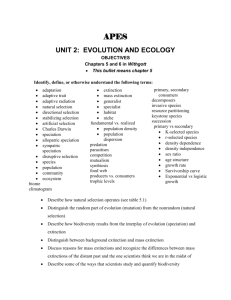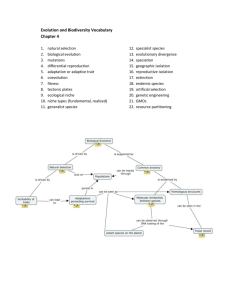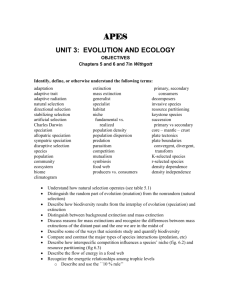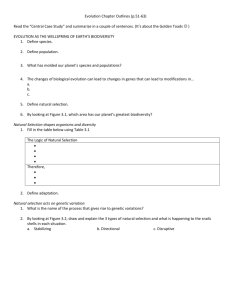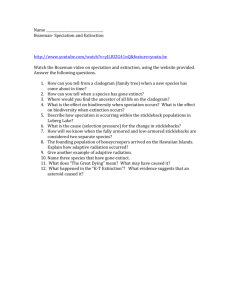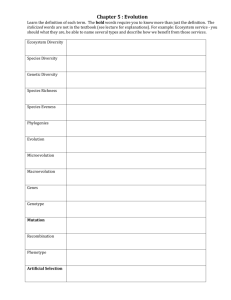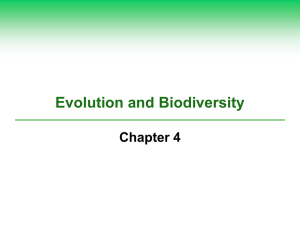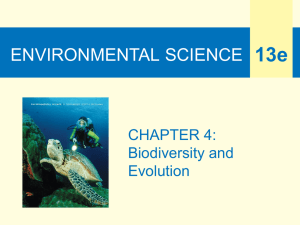Miller Chap 5 - Evolution, Biodiversity, Community Processes
advertisement
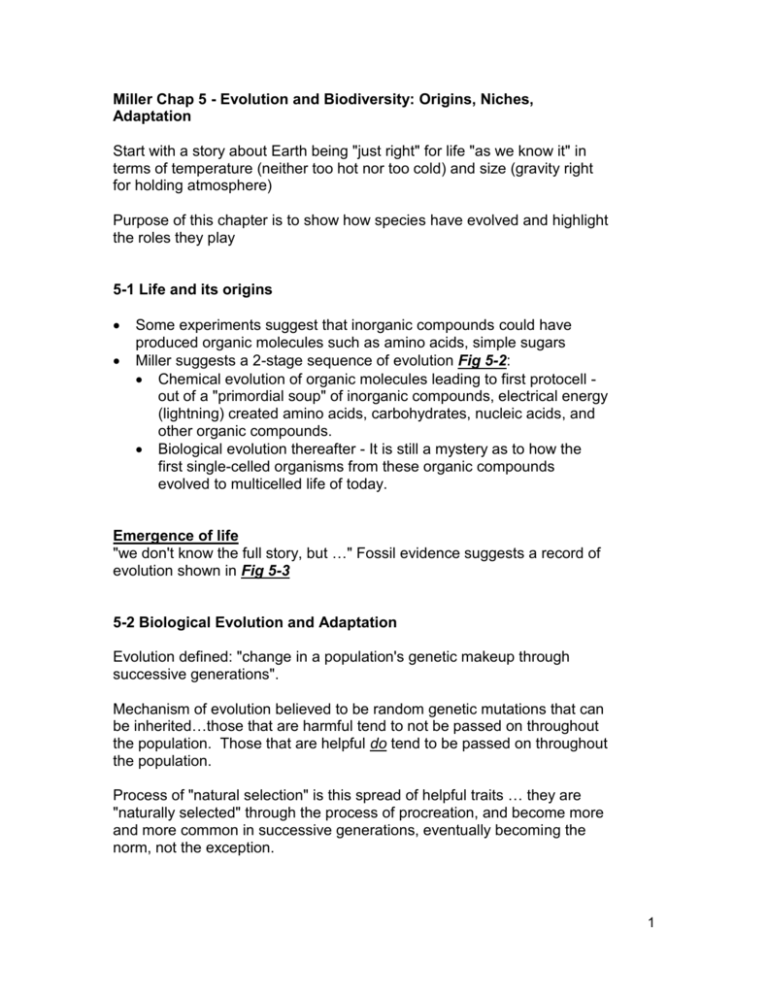
Miller Chap 5 - Evolution and Biodiversity: Origins, Niches, Adaptation Start with a story about Earth being "just right" for life "as we know it" in terms of temperature (neither too hot nor too cold) and size (gravity right for holding atmosphere) Purpose of this chapter is to show how species have evolved and highlight the roles they play 5-1 Life and its origins Some experiments suggest that inorganic compounds could have produced organic molecules such as amino acids, simple sugars Miller suggests a 2-stage sequence of evolution Fig 5-2: Chemical evolution of organic molecules leading to first protocell out of a "primordial soup" of inorganic compounds, electrical energy (lightning) created amino acids, carbohydrates, nucleic acids, and other organic compounds. Biological evolution thereafter - It is still a mystery as to how the first single-celled organisms from these organic compounds evolved to multicelled life of today. Emergence of life "we don't know the full story, but …" Fossil evidence suggests a record of evolution shown in Fig 5-3 5-2 Biological Evolution and Adaptation Evolution defined: "change in a population's genetic makeup through successive generations". Mechanism of evolution believed to be random genetic mutations that can be inherited…those that are harmful tend to not be passed on throughout the population. Those that are helpful do tend to be passed on throughout the population. Process of "natural selection" is this spread of helpful traits … they are "naturally selected" through the process of procreation, and become more and more common in successive generations, eventually becoming the norm, not the exception. 1 - - - Interesting peppered moth story highlighting evolution and natural selection Fig 5-4: Light-colored moths were prevalent in pre-Industrial England, when they blended in with light-colored lichen on trees and were protected from predators. Dark-colored moths became dominant after trees became darkened with soot in post-Industrial England, and predators started eating all the light-colored moths. Moral of the story: dark-colored moths much better equipped to survive, those are the ones whose traits become more widespread throughout the population Miller notes 3 common misconceptions about evolution: 1. "survival of the fittest" is a misnomer, because it suggests "tooth and claw" competition. Reality is that this means that fittest species are those that best work with their environment to survive. 2. "man evolved from the apes" - actually, the theory is that man and apes separately evolved from some common ancestor, hundreds of thousands, perhaps millions, of years ago. 3. "grand plan of species becoming more perfect" - no such plan, that we know of, exists. Genetic mutations are random, and if they are of benefit to a species' survival they will be passed on over time throughout the population. 5-3 Ecological Niches and adaptation Niche defined - a species' role in an ecosystem "niche is a species' occupation, and a habitat is its address" Miller distinguishes between a "fundamental" and a "realized" niche…fundamental is what it could theoretically occupy, with no competition. But there usually IS competition, so the realized niche is different. Miller uses a corporate professional analogy…you COULD be a CEO, but due to competition you are only a VP Generalist vs Specialist - important distinctions of these types of species (Fig 5-6) Generalists: -live in many diff areas -eat diff foods -tolerate wide range of envir conditions examples: flies, cockroaches, mice, rats, deer, raccoons, catfish, humans 2 Specialists: -live in very limited habitat -eat narrow range of food -tolerate a narrow range of conditions specialists tend to really dominate when conditions are right (Dinosaurs in the Mesozoic), but they are more prone to extinction than generalists because they don't like change….. 5-4 Speciation, extinction, biodiversity Speciation - process of 2 species arising from one - example of arctic and gray fox developing from common ancestor….(Fig 5-7)…each develops certain characteristics that are well-suited to particular environment (cold vs hot) Mechanism first, the original population is split into 2 groups, and they become geographically isolated second, mutation operates independently in each of the populations, and their gene pools become different through reproductive isolation. They may look the same, but can no longer interbreed. This is what Darwin observed with species in the Galapagos Is off S. America - they looked almost identical to species on the mainland, but were different enough to be unable to interbreed Extinction When environmental conditions change, species can essentially go one of 3 ways…. - they can either continue to evolve and survive in the new environment, - move to a new environment in which they will prosper, or - they can die off in large numbers and become extinct. Most mass extinctions are thought to result from large-scale changes, like plates drifting through different climates (Fig 5-8). Look carefully at India, which migrated from the South Pole to the equator in the last 225 m.y. Other causes include rapid climate change (warming or cooling) perhaps associated with huge volcanic eruptions and dust clouds cutting off large amounts of sunlight. These changes kill off many species, but leave behind those that are able to adapt to the new reality and continue to procreate. Mass extinctions are not new - some big ones have occurred over last 500 million years Fig 5-9 3 Biodiversity Speciation - extinction = biodiversity This simple equation says, the more species you get, and the less amount of extinctions that happen, will result in the largest biodiversity. 4
